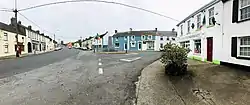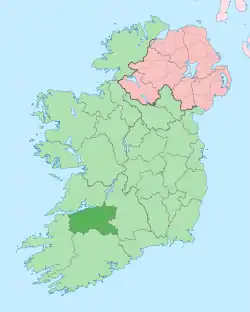Ballylanders
Ballylanders (Irish: Baile an Londraigh) is a village in south County Limerick, Ireland. It is situated on the R513; Mitchelstown-Limerick regional road, being approximately 14 km. from the former and 44 km. from the latter. The 2016 census recorded a population of 308 people.[1]
Ballylanders
Baile an Londraigh | |
|---|---|
Village | |
 Main Street | |
 Ballylanders Location in Ireland | |
| Coordinates: 52°22′22″N 8°20′58″W | |
| Country | Ireland |
| Province | Munster |
| County | County Limerick |
| Elevation | 146 m (479 ft) |
| Population (2016)[1] | 308 |
| Time zone | UTC+0 (WET) |
| • Summer (DST) | UTC-1 (IST (WEST)) |
| Irish Grid Reference | R810270 |
| Website | ballylanders |
Name
Historically the name translates as ‘de Londra's town’ [2] and is most likely of Norman origin and referring to a popular Anglo-Norman derived family surname of "Landers" or alternatively "de Londra" can give its translation as "Town of the Londoner".
Amenities
There is a holy well close to the village which is the focal point of the Pattern day, held annually on 15 August, this is one of the major such fair days in the locality. In 2011 The Wolfe Tones performed in the marquee during the pattern festival.
The present day Catholic parish church is of a modern circular design. The first church in the village was a Church of Ireland church, dated to the 19th century, is still in existence today as a private dwelling house. The arches of the church are still visible from the inside and are preserved for aesthetic value.
Griston Bog, on the west side of the village, is a nature reserve and bird sanctuary which is home to birds, insects and plants.
Sports
Ballylanders Gaelic Athletic Association club has won the Limerick county Senior Football championship in 1917, 1999, 2007 and 2015.
Ballylanders Soccer Club which was first established in 1987, and caters for boys and girls of all age groups and has over 200 registered members. The club purchased its own grounds in 1992 and the 7.5-acre (30,000 m2) facility comprises a clubhouse, two full-size playing pitches and a full-size floodlit training pitch. The club has also developed an amenity walk around the perimeter of its ground and has completed the planting of 250 native hardwood trees in part of their facility which was unsuitable for development as a playing area. Development work on their facility is funded through a weekly lottery, with tickets available from local pubs and shops.
Notable people
Frank Dineen (1862–1916) was one of Munster's most promising athletes of the early 1880s. Later he became the only person to ever hold both posts of president (1885–1898) and Secretary (1898–1901) of the G.A.A., as Secretary he tried to restore financial stability when the Association was threatened with bankruptcy. In 1907 he fronted the purchase of the Croke Park site out of his own personal finances for £3,250.[3] He was the writer of the Gaelic column in the influential weekly 'Sport' for many years. Prominent in Land League and Fenian movements, he became a supporter of John Redmond after the turn of century. He is buried in Glasnevin Cemetery. The house in Ballylanders where he was born is now owned by the MacDermott family.
Tadhg Crowley (1890-1970) was an Irish Fianna Fáil politician. He was first elected to Dáil Éireann as a Teachta Dála (TD) for the Limerick constituency at the June 1927 general election.
John Crowley (1891-1942) was an Irish revolutionary and hunger striker, holding the Guinness World Record for the longest hunger strike in history - 94 days. From 11 August to 12 November 1920 in Cork County Gaol, John, his younger brother Peter William Crowley, and 10 others underwent a hunger strike of 94 days, demanding the reinstatement of their political status and release from prison. Their strike was in sympathy with that of the Lord Mayor of Cork, Terence MacSwiney, imprisoned in Brixton Gaol, who died there on hunger strike in 1920.
Peter William Crowley (1900-1963) was an Irish revolutionary and hunger striker who took part in the same Hunger strike as his elder brother John.
Services
There is a local transport service in the locality known as Ballyhoura Travel.
References
- "Census 2016 - Sapmap Area - Settlements - Ballylanders". Census 2016. Central Statistics Office. 2016. Retrieved 12 August 2019.
- Mills, A. D., A Dictionary of British Place-Names, Oxford University Press (2003)
- Carey, Tim: Croke Park: a history, The Collins Press (Ireland), 2007 Paperback, 200 pages ISBN 978-1-905172-08-5 (1905172087)
